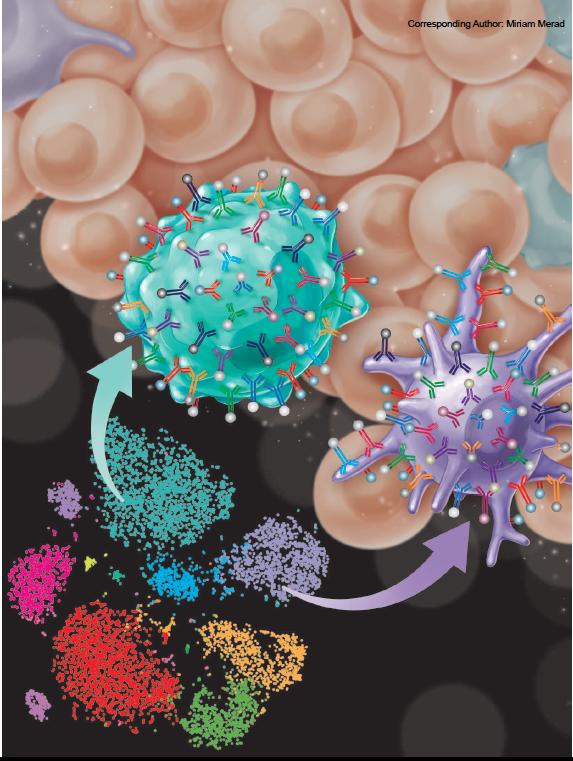![This image illustrates the use of CyTOF, or single cell mass cytometry, technology in performing a paired analysis of barcoded blood, noninvolved lung, and freshly resected tumor samples to characterize immune compartments with an unprecedented granularity. [Miriam Merad/Icahn School of Medicine at Mount Sinai]](https://genengnews.com/wp-content/uploads/2018/08/May5_2017_MiriamMerad_CyTOFTechnologyIllustration2211522122-1.jpg)
This image illustrates the use of CyTOF, or single cell mass cytometry, technology in performing a paired analysis of barcoded blood, noninvolved lung, and freshly resected tumor samples to characterize immune compartments with an unprecedented granularity. [Miriam Merad/Icahn School of Medicine at Mount Sinai]
Two independent studies have begun mapping connections among the thousands of immune cells surrounding human tumors. One research group, looking at kidney cancer, found that tumors with different clinical outcomes have unique immune cell profiles that can also estimate a cancer patient's prognosis. The other team, looking at lung cancer, showed that even early tumors have disturbed immune cell activity. Both papers, published in Cell, may lead to better designed precision immunotherapy clinical trials.
“We've found that immune cells start to be dysfunctional very early during tumor formation, but immunotherapy is not typically given until patients relapse and the cancer is advanced,” says Miriam Merad, M.D., Ph.D., senior author of the lung cancer study (“Innate Immune Landscape in Early Lung Adenocarcinoma by Paired Single-Cell Analyses”), of the Icahn School of Medicine at Mount Sinai in New York. “We want to advocate for starting immunotherapy early, before it is too late.”
“Basic researchers are going to be very excited for this toolbox because they can study their immune cell or pathway of interest with higher resolution and compare it across individual tumors or tumor types,” notes Bernd Bodenmiller, Ph.D., senior author of the kidney cancer paper (“An Immune Atlas of Clear Cell Renal Cell Carcinoma”), of the University of Zürich in Switzerland. “For translational researchers, knowing that there are these immune cell differences among patients' tumors presents a tantalizing possibility for personalized immunotherapy.”
A tumor's ability to grow unchecked is helped by its recruitment of immune cells to keep it hidden from the rest of the immune system. Tumors become so entrenched with immune cells that they form mini ecosystems, with cell-to-cell relationships not seen in normal tissues. The atlases reveal these ecosystems and the connections between tumor immune, such as which immune cells are present in a specific tumor and the frequency of a given cell type, as well as their functional potential.
Both studies generated the atlases by tagging single immune cells around the tumor with 30 to 40 antibodies that could bind to specific markers known to be present on various cells. Using this information, a detector could screen the cells and reveal their identities and whether the cells are functional or defective.
“I think when most people see our data, they will first react with the thought that it's pure chaos,” says Dr. Bodenmiller, whose group looked at tumor samples from 73 patients with renal cell carcinoma. “But if you look at the distributions of the cell phenotypes for a bit longer, you will see patterns. And then computational analysis reveals that there are relationships between the cell types in the tumor ecosystem that relate to a clinical outcome. We can even put this information into an equation and estimate survival.”
Dr. Merad's team studied tumor samples and normal tissue from 28 patients at early or advanced stages of lung adenocarcinoma. Their analysis saw changes in cell type behavior much earlier than anticipated. Stage 1 tumors already showed a rich gathering of suppressive macrophages and T cells, as well as the depletion of natural killer (NK) cells that help activate the immune system. These tumors are typically removed surgically, and while they usually have a good prognosis, 25% of patients relapse.
“In this study we identified many immune suppressive changes that could be targeted to induce an immune attack and an immune memory response against these small tumors, and we are currently testing these questions in animal models,” Dr. Merad says. “We are very excited about these results because we believe that targeting tumor cells at this small stage has much higher chances to get rid of all tumor cells than if we unleashed an immune attack in larger tumors where risk of tumor cell dissemination is higher.”
Both groups described the creation of their atlases as significant undertakings and expensive, which means that it won't be something that can be used as a standard of care anytime soon. Dr. Bodenmiller predicts the technique will follow the same course as human genome sequencing, in which costs will fall over time.
Dr. Merad maintains that generating and sharing these atlases with the cancer research community provides unprecedented knowledge about the cancer immune microenvironment and will help foster knowledge and the rational design of clinical trials.






